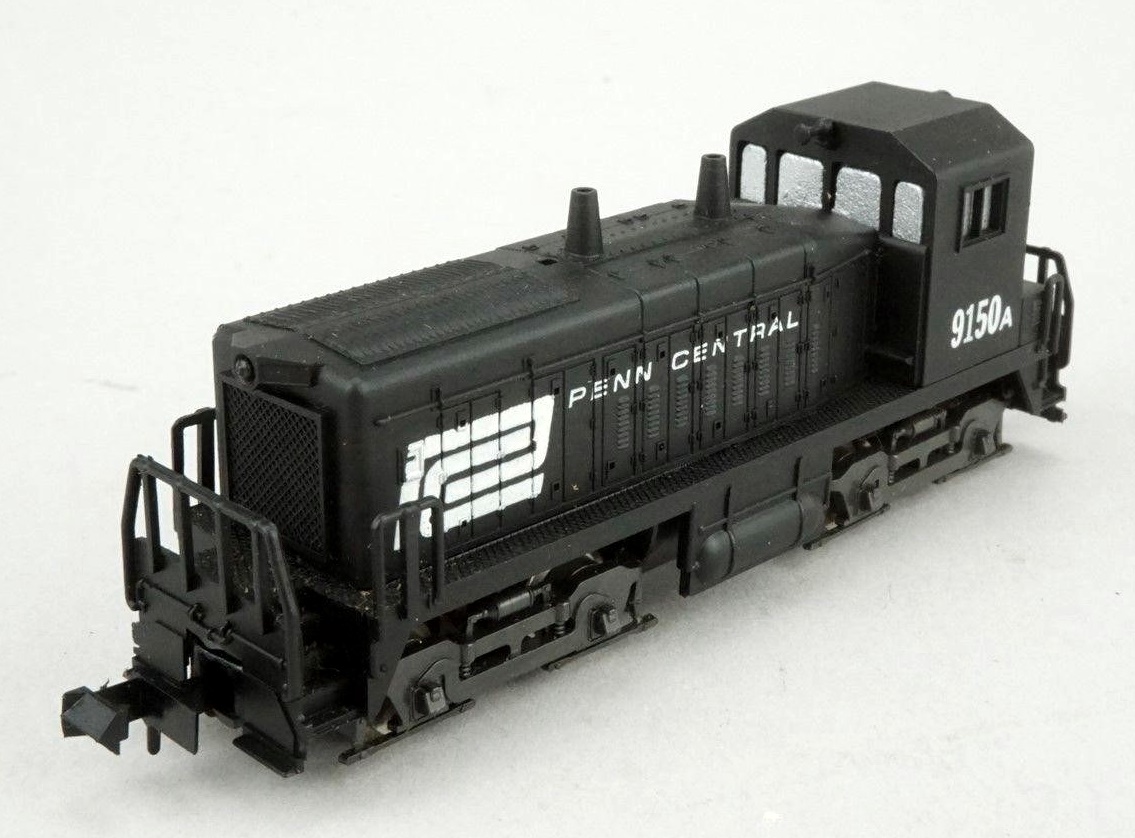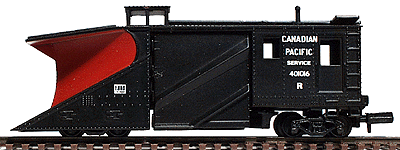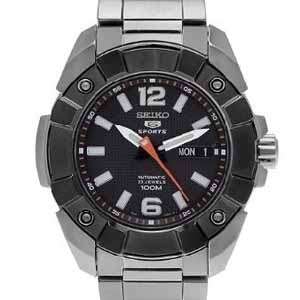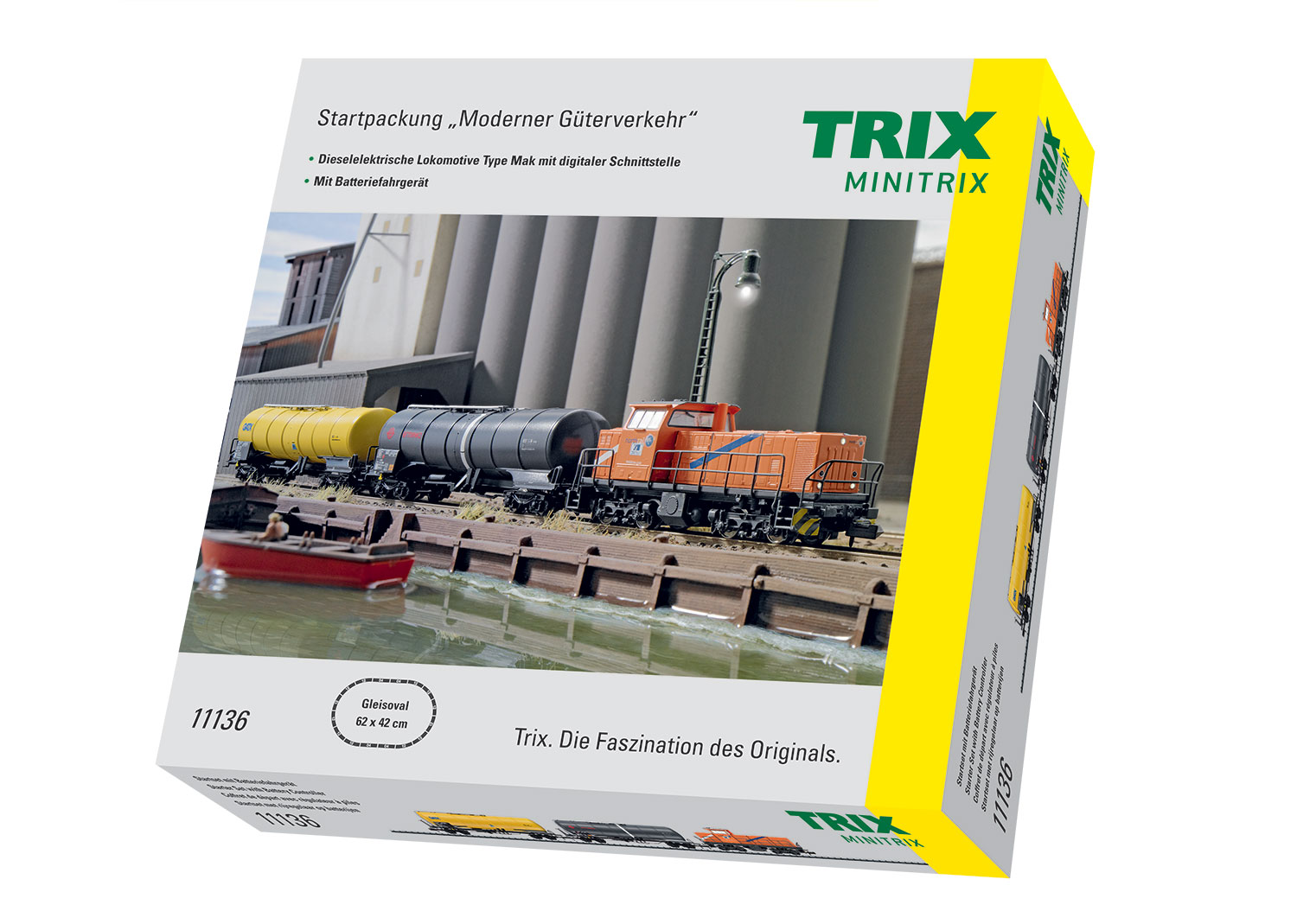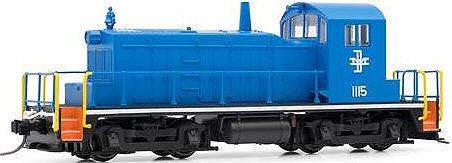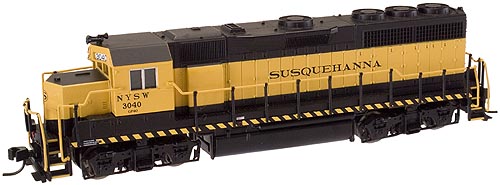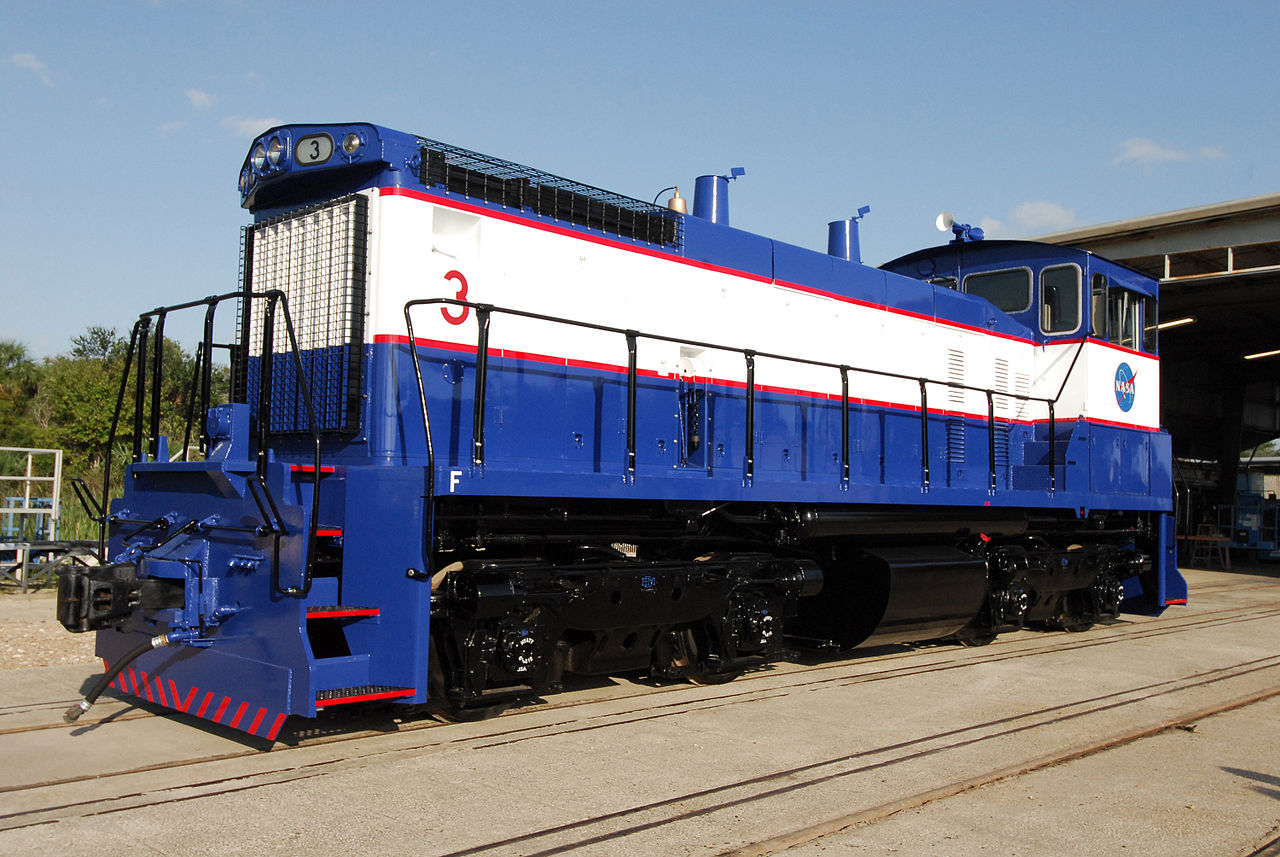Model Information: This body style is for the Con-Cor versions with Rivarossi, Kato or Con-Cor mechanisms.
This model was first produced by Rivarossi for Atlas in 1971. The trucks are marked 'Made in Italy' with a Rivarossi logo and an Atlas logo. The motor is visible from below on the powered cow. On the dummy calf, a large hollow can be seen from the bottom of the model, corresponding to the missing motor.
After Atlas stopped ordering them ca. 1977, Rivarossi continued selling them with its own brand and reference (#91xx) and released one additional paint scheme (SP Black Widow) in 1980. Con-Cor also began importing the Rivarossi model. On this model, the trucks are marked 'Made in Italy' with a Rivarossi logo only.
The Rivarossi/Con-Cor version was available powered or unpowered, for both the cow and the calf. The Con-Cor stock numbers are in the form 5001 or 5002 (powered cow), 5011 or 5012 (unpowered cow), 5021 or 5022 (powered calf), 5031 or 5032 (unpowered calf), followed by a letter assigned for each road name.
The boxes can also be labeled with a Rivarossi stock number on one end and a Con-Cor stock number on the other end, sometimes printed on a Rivarossi label.
Models not in Rivarossi catalog, so only sold by Con-Cor, may still show a Rivarossi stock number, corresponding to the type of chassis - #9288 (dummy calf) or #9289 (dummy cow) or #9290 (powered cow) - on one side and a Con-Cor stock number on the other side. The Con-Cor number was on a sticker which tended to detach with age, leaving only the printed Rivarossi number. Hence many classifieds are using the non-distinctive Rivarossi number 9288 or 9289 or 9890.
At a certain point ca. 1985, apparently dissatisfied with the mechanisms made by Rivarossi, Con-Cor had Kato design a new, more reliable, mechanism but continued use of the Rivarossi shell. This new Kato/Rivarossi hybrid was produced until 1989. The change of mechanism only applied to the 'cow' powered unit; the 'calf' dummy unit continued to be fully made by Rivarossi. On the powered cow, the trucks are marked '17712/Made in Japan' with Kato logo and the fuel tank is marked 'Con-Cor' on the bottom.
In 1996, Arnold/Rivarossi re-released the same model with yet another new mechanism and a few improvements of the shell (thinner handrails and tank details). On this model, the fuel tank is marked 'Arnold/Made in Germany'. The couplers are truck-mounted.
In 1997, Con-Cor released a new version of the model this time using a Chinese manufactured mechanism, but with the shell still more or less the same. These Chinese versions were marketed as SW-1200s. The bottom of the trucks is marked '17712/Made in China', without logo. The 'calf' dummy unit still continued to be fully made by Rivarossi
Con-Cor stopped making their version during the downsizing in 2005 and Arnold stopped producing theirs in 2006 with the bankruptcy.
Adding to the confusion, Con-Cor decided to re-use for the 1997 SW-1200 cow version, the same stock number range that was used for the previous Kato version sets (cow/calf). So any stock number from 0001-005000 to 0001-005023 can refer to one or the other.
The model was designed from early EMD drawings for the SW1500 prototype, that were quite similar to the SW1200 drawings. Eventually the final SW1500 prototype was released with significant changes to the early drawing. So though the model is sold as a SW1500, it is actually closer to a SW1200 than to a SW1500. Moreover, if a cow-calf version of the SW1200 (TR12) was offered in the catalog, it was actually never purchased. No cow-calf version of the SW1500 was ever envisaged.
This model was first produced by Rivarossi for Atlas in 1971. The trucks are marked 'Made in Italy' with a Rivarossi logo and an Atlas logo. The motor is visible from below on the powered cow. On the dummy calf, a large hollow can be seen from the bottom of the model, corresponding to the missing motor.
After Atlas stopped ordering them ca. 1977, Rivarossi continued selling them with its own brand and reference (#91xx) and released one additional paint scheme (SP Black Widow) in 1980. Con-Cor also began importing the Rivarossi model. On this model, the trucks are marked 'Made in Italy' with a Rivarossi logo only.
The Rivarossi/Con-Cor version was available powered or unpowered, for both the cow and the calf. The Con-Cor stock numbers are in the form 5001 or 5002 (powered cow), 5011 or 5012 (unpowered cow), 5021 or 5022 (powered calf), 5031 or 5032 (unpowered calf), followed by a letter assigned for each road name.
The boxes can also be labeled with a Rivarossi stock number on one end and a Con-Cor stock number on the other end, sometimes printed on a Rivarossi label.
Models not in Rivarossi catalog, so only sold by Con-Cor, may still show a Rivarossi stock number, corresponding to the type of chassis - #9288 (dummy calf) or #9289 (dummy cow) or #9290 (powered cow) - on one side and a Con-Cor stock number on the other side. The Con-Cor number was on a sticker which tended to detach with age, leaving only the printed Rivarossi number. Hence many classifieds are using the non-distinctive Rivarossi number 9288 or 9289 or 9890.
At a certain point ca. 1985, apparently dissatisfied with the mechanisms made by Rivarossi, Con-Cor had Kato design a new, more reliable, mechanism but continued use of the Rivarossi shell. This new Kato/Rivarossi hybrid was produced until 1989. The change of mechanism only applied to the 'cow' powered unit; the 'calf' dummy unit continued to be fully made by Rivarossi. On the powered cow, the trucks are marked '17712/Made in Japan' with Kato logo and the fuel tank is marked 'Con-Cor' on the bottom.
In 1996, Arnold/Rivarossi re-released the same model with yet another new mechanism and a few improvements of the shell (thinner handrails and tank details). On this model, the fuel tank is marked 'Arnold/Made in Germany'. The couplers are truck-mounted.
In 1997, Con-Cor released a new version of the model this time using a Chinese manufactured mechanism, but with the shell still more or less the same. These Chinese versions were marketed as SW-1200s. The bottom of the trucks is marked '17712/Made in China', without logo. The 'calf' dummy unit still continued to be fully made by Rivarossi
Con-Cor stopped making their version during the downsizing in 2005 and Arnold stopped producing theirs in 2006 with the bankruptcy.
Adding to the confusion, Con-Cor decided to re-use for the 1997 SW-1200 cow version, the same stock number range that was used for the previous Kato version sets (cow/calf). So any stock number from 0001-005000 to 0001-005023 can refer to one or the other.
The model was designed from early EMD drawings for the SW1500 prototype, that were quite similar to the SW1200 drawings. Eventually the final SW1500 prototype was released with significant changes to the early drawing. So though the model is sold as a SW1500, it is actually closer to a SW1200 than to a SW1500. Moreover, if a cow-calf version of the SW1200 (TR12) was offered in the catalog, it was actually never purchased. No cow-calf version of the SW1500 was ever envisaged.
DCC Information: No provision for DCC, except on the Arnold version.
Prototype History: The EMD SW1500 was a 1,500 hp (1,119 kW) Diesel-electric locomotive intended for switching service and built by General Motors' Electro-Motive Division between June 1966 and January 1974. 808 examples were constructed. It was closely related to the less powerful EMD SW1000 model, forming a line of switchers powered by the new EMD 645 engine. The SW1500 replaced the SW1200 in the EMD product line, and was in turn replaced by the MP15DC.
The SW1500 was a substantially bulkier locomotive than the SW1200, with a much bulkier frame, larger cab and bigger hood. In many respects it was approaching a road switcher in abilities. While the SW1500 came as standard with AAR switcher trucks, the majority of them were delivered with the optional Flexicoil trucks which permitted speeds up to 60 mph (100 km/h). The SW1500 was, in fact, often operated as a road-switcher for branchline service, and continues in this role today.
From Wikipedia
The SW1500 was a substantially bulkier locomotive than the SW1200, with a much bulkier frame, larger cab and bigger hood. In many respects it was approaching a road switcher in abilities. While the SW1500 came as standard with AAR switcher trucks, the majority of them were delivered with the optional Flexicoil trucks which permitted speeds up to 60 mph (100 km/h). The SW1500 was, in fact, often operated as a road-switcher for branchline service, and continues in this role today.
From Wikipedia
Road Name History:  The Penn Central Transportation Company, commonly abbreviated to Penn Central, was an American Class I railroad headquartered in Philadelphia, Pennsylvania, that operated from 1968 until 1976. It was created by the 1968 merger of the Pennsylvania and New York Central railroads. The New York, New Haven & Hartford Railroad was added to the merger in 1969; by 1970, the company had filed for what was, at that time, the largest bankruptcy in U.S. history.
The Penn Central Transportation Company, commonly abbreviated to Penn Central, was an American Class I railroad headquartered in Philadelphia, Pennsylvania, that operated from 1968 until 1976. It was created by the 1968 merger of the Pennsylvania and New York Central railroads. The New York, New Haven & Hartford Railroad was added to the merger in 1969; by 1970, the company had filed for what was, at that time, the largest bankruptcy in U.S. history.
The Penn Central was created as a response to challenges faced by all three railroads in the late 1960s. The northeastern quarter of the United States, these railroads' service area, was the most densely populated region of the U.S. While railroads elsewhere in North America drew a high percentage of their revenues from the long-distance shipment of commodities such as coal, lumber, paper and iron ore, Northeastern railroads traditionally depended on a mix of services.
As it turned out, the merged Penn Central was little better off than its constituent roads were before. A merger implementation plan was drawn up, but not carried out. Attempts to integrate operations, personnel and equipment were not very successful, due to clashing corporate cultures, incompatible computer systems and union contracts. Track conditions deteriorated (some of these conditions were inherited from the three merged railroads) and trains had to be run at reduced speeds. This meant delayed shipments and personnel working a lot of overtime. As a result, operating costs soared. Derailments and wrecks became frequent, particularly in the midwest.
The American financial system was shocked when after only two years of operations, the Penn Central Transportation company was put into bankruptcy on June 21, 1970. It was the largest corporate bankruptcy in American history at that time. Although the Penn Central Transportation Company was put into bankruptcy, its parent Penn Central Company was able to survive.
The Penn Central continued to operate freight service under bankruptcy court protection. After private-sector reorganization efforts failed, Congress nationalized the Penn Central under the terms of the Railroad Revitalization and Regulatory Reform Act of 1976. The new law folded six northeastern railroads, the Penn Central and five smaller, failed lines, into the Consolidated Rail Corporation, commonly known as Conrail. The act took effect on April 1, 1976.
Read more on Wikipedia.

The Penn Central was created as a response to challenges faced by all three railroads in the late 1960s. The northeastern quarter of the United States, these railroads' service area, was the most densely populated region of the U.S. While railroads elsewhere in North America drew a high percentage of their revenues from the long-distance shipment of commodities such as coal, lumber, paper and iron ore, Northeastern railroads traditionally depended on a mix of services.
As it turned out, the merged Penn Central was little better off than its constituent roads were before. A merger implementation plan was drawn up, but not carried out. Attempts to integrate operations, personnel and equipment were not very successful, due to clashing corporate cultures, incompatible computer systems and union contracts. Track conditions deteriorated (some of these conditions were inherited from the three merged railroads) and trains had to be run at reduced speeds. This meant delayed shipments and personnel working a lot of overtime. As a result, operating costs soared. Derailments and wrecks became frequent, particularly in the midwest.
The American financial system was shocked when after only two years of operations, the Penn Central Transportation company was put into bankruptcy on June 21, 1970. It was the largest corporate bankruptcy in American history at that time. Although the Penn Central Transportation Company was put into bankruptcy, its parent Penn Central Company was able to survive.
The Penn Central continued to operate freight service under bankruptcy court protection. After private-sector reorganization efforts failed, Congress nationalized the Penn Central under the terms of the Railroad Revitalization and Regulatory Reform Act of 1976. The new law folded six northeastern railroads, the Penn Central and five smaller, failed lines, into the Consolidated Rail Corporation, commonly known as Conrail. The act took effect on April 1, 1976.
Read more on Wikipedia.
Brand/Importer Information: Con-Cor has been in business since 1962. Many things have changed over time as originally they were a complete manufacturing operation in the USA and at one time had upwards of 45 employees. They not only designed the models,but they also built their own molds, did injection molding, painting, printing and packaging on their models.
Currently, most of their manufacturing has been moved overseas and now they import 90% of their products as totally finished goods, or in finished components. They only do some incidental manufacturing today within the USA.
Important Note: The Con-Cor product numbering can be very confusing. Please see here in the article how to properly enter Con-Cor stock numbers in the TroveStar database.
Currently, most of their manufacturing has been moved overseas and now they import 90% of their products as totally finished goods, or in finished components. They only do some incidental manufacturing today within the USA.
Important Note: The Con-Cor product numbering can be very confusing. Please see here in the article how to properly enter Con-Cor stock numbers in the TroveStar database.
Item created by: Alain LM on 2022-01-31 04:39:06. Last edited by Alain LM on 2022-01-31 04:41:45
If you see errors or missing data in this entry, please feel free to log in and edit it. Anyone with a Gmail account can log in instantly.
If you see errors or missing data in this entry, please feel free to log in and edit it. Anyone with a Gmail account can log in instantly.


